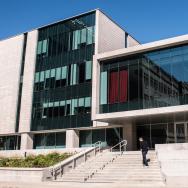Originally built in 1965 with NASA funding, the building is home to members of UChicago’s Department of Physics as well as the Enrico Fermi Institute, founded shortly after World War II to pursue experimental and theoretical research in high-energy particle physics, astrophysics, plasma physics and other fields; and the Kadanoff Center for Theoretical Physics, which brings together scientists across disciplines—from condensed matter physics to string theory and hydrodynamics—to accelerate inquiry into fundamental questions.
“Albert Michelson’s work changed the prevailing paradigm of his time when he showed the absence of the luminiferous aether, motivating the theory of relativity and the dawn of modern physics. Scientists today continue to build on the foundations that Michelson’s work forged,” said Angela Olinto, dean of the Division of the Physical Sciences and the Albert A. Michelson Distinguished Service Professor in the Department of Astronomy and Astrophysics.
A gift for measurement
Michelson immigrated to the U.S. from Poland as a child and was appointed to the Naval Academy on recommendation from President Ulysses S. Grant. In experiments in the 1880s, he and colleague Edward Morley formulated a way to make an astoundingly accurate measurement of the speed of light, which they wanted to know in order to test a theory popular at the time, which held that space was permeated with a medium known as “ether.” The measurement instead served later to bolster Einstein’s special theory of relativity.
Michelson moved to the University of Chicago in 1892 to launch a physics department that matched the considerable ambitions of the University. He oversaw the hiring of several colleagues who would later receive their own Nobel Prizes, including Robert Millikan and Arthur Holly Compton.
Michelson directed the construction of Ryerson Laboratory, which he insisted had to be built without a speck of iron so that stray magnetism would not interfere with experiments. The building would go on to house parts of the Manhattan Project, as well as countless other scientific discoveries in physics and chemistry.
Throughout his prolific scientific career, Michelson displayed a gift for measurement. Using his optical devices, he noticed that a particular wavelength of red light was so constant that it would make an ideal way to standardize the international length of a meter—and his measurement stood as the standard for decades. In 1920, he became the first person to measure the diameter of a distant star, using an optical device to estimate the size of Betelgeuse, the brightest star in the constellation of Orion.
Around the same time, he buried two tubes in the ground 500 feet apart, filled them partially with water, and then watched as the sun and moon made miniature “tides” in each one—and from this made a measurement of the Earth’s rigidity.











 —Prof. Kunle Odunsi
—Prof. Kunle Odunsi
